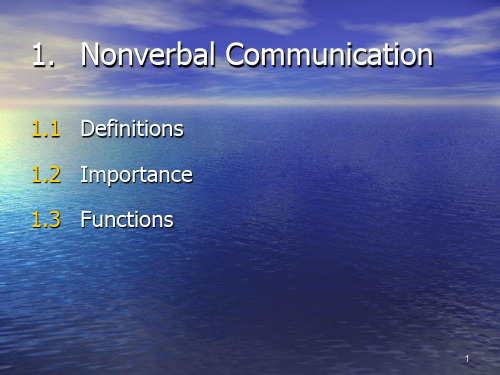跨文化交际-英文ppt
合集下载
跨文化交际PPT演示课件

23
3. Space and Distance
3.1 Proxemics 3.2 Attitudes Toward Crowding
24
3.1 Proxemics
✓ Definition: the study of people’s perception and use of space.
✓ Four categories: intimate, personal, social, and public distance.
26
Categories of Distance (cont’d)
• Social Distance (1.3-3m) - colleagues, business partners, people at social gatherings
• Public Distance (beyond 3m) - speaking in public
- direct intrusion into others’ affairs • Shrugging shoulders
- indifferent, powerless, having no secret to conceal
19
Postures (cont’d)
• Follow one’s natural habits so often go unnoticed (subconscious in nature)
• May damage your image if you neglect your postures
20
2.4 Eye Contact
Direct eye contact • Chinese: avoid • North Americans: appreciate • The British: avoid
3. Space and Distance
3.1 Proxemics 3.2 Attitudes Toward Crowding
24
3.1 Proxemics
✓ Definition: the study of people’s perception and use of space.
✓ Four categories: intimate, personal, social, and public distance.
26
Categories of Distance (cont’d)
• Social Distance (1.3-3m) - colleagues, business partners, people at social gatherings
• Public Distance (beyond 3m) - speaking in public
- direct intrusion into others’ affairs • Shrugging shoulders
- indifferent, powerless, having no secret to conceal
19
Postures (cont’d)
• Follow one’s natural habits so often go unnoticed (subconscious in nature)
• May damage your image if you neglect your postures
20
2.4 Eye Contact
Direct eye contact • Chinese: avoid • North Americans: appreciate • The British: avoid
跨文化交际(UNIT-8)-PPT

Idioms which are culturally loaded include:
Belgian hare, Dutch barn, French letter, German measles, Greek gifts and Swedish drill.
French Leave and Dutch Courage (p265-267)
Dutch uncle. 3. I don’t understand this book at all, it’s all Greek to
me! 4. If you wanted me to go, why didn’t you say so in
plain English instead of making vague hints? 5. Scratch a Russian, and you’ll find a Tartar. Do you
French Leave and Dutch
Courage (p265-267)
➢ Do you know some terms and expressions in English that are formed with names of other nationalities?
Danish pastry, Flemish bond, Irish stew, Italic handwriting, Portuguese man-or-war, Russian roulette, Spanish fly, Scotch pine, Swiss roll, Turkish delight and Welsh rarebit;
“And how did you get the American to jump?”
Belgian hare, Dutch barn, French letter, German measles, Greek gifts and Swedish drill.
French Leave and Dutch Courage (p265-267)
Dutch uncle. 3. I don’t understand this book at all, it’s all Greek to
me! 4. If you wanted me to go, why didn’t you say so in
plain English instead of making vague hints? 5. Scratch a Russian, and you’ll find a Tartar. Do you
French Leave and Dutch
Courage (p265-267)
➢ Do you know some terms and expressions in English that are formed with names of other nationalities?
Danish pastry, Flemish bond, Irish stew, Italic handwriting, Portuguese man-or-war, Russian roulette, Spanish fly, Scotch pine, Swiss roll, Turkish delight and Welsh rarebit;
“And how did you get the American to jump?”
大学英语跨文化交际案例分析课堂PPT演示样本

Case Three: Cultural Misunderstandings in International Tourism
• Summary: Cultural Misunderstandings in International Tourism
Case Three: Cultural Misunderstandings in International Tourism
• Detailed description • Catering habits: ts from different cultural backgrounds may have
different dining habits and preferences. For example, some cultures may prefer spicy food, while others may place more emphasis on a light and healthy diet. • Etiquette and Customs: During the tourism process, tourists need to understand and abide by local etiquette and customs. For example, in some cultures, touching someone's head or using the left hand is considered impolite and disrespectful behavior. • Language expression: In cross-cultural communication, differences in language expression may lead to misunderstandings and conflicts. For example, some languages may have specific expressions or implicit meanings, which may lead to communication barriers if not understood.
跨文化交际(英文PPT)

the issues concerning intercultural communication .
III. Plan.
1.Required Textbook :Communication Between Cultures (Third Edition)By Larry A. Samovar Richard E. Porter Lisa A. Stefani 2000 2. Time schedule: 36 periods in one term. 1).Introduction to Intercultural Communication ;4periods 2).Part I Communication and Culture; 8 periods 3).Part II The Influence of Culture ; 8 periods 4).Part III From Theory of Practice; 8 periods 5).Part IV Knowledge into Action; 8 periods 3. Evaluation will be based on: 1)Attendance and participation. 2)Project presentation and handout (the required essay ). 3)Final examination.
The book is divided into four interrelated parts, including 10 chapters: (Look at P.F28)
Part I introduces the study of communication and culture(Chapter1-2);
III. Plan.
1.Required Textbook :Communication Between Cultures (Third Edition)By Larry A. Samovar Richard E. Porter Lisa A. Stefani 2000 2. Time schedule: 36 periods in one term. 1).Introduction to Intercultural Communication ;4periods 2).Part I Communication and Culture; 8 periods 3).Part II The Influence of Culture ; 8 periods 4).Part III From Theory of Practice; 8 periods 5).Part IV Knowledge into Action; 8 periods 3. Evaluation will be based on: 1)Attendance and participation. 2)Project presentation and handout (the required essay ). 3)Final examination.
The book is divided into four interrelated parts, including 10 chapters: (Look at P.F28)
Part I introduces the study of communication and culture(Chapter1-2);
跨文化交际英文英语ppt

• In life some minor a neglected social practice can also be seen as the differences in Western culture. For example, Westerners think the sound while eating is not appropriate. But eat in Asian the sound is considered to the cook, appreciation and satisfaction.
prayer.
• 还有不同文化中不同的祷告仪式。 • There are different culture in different prayer.
Different culture in different prayer.
东西方文化中不同的葬礼仪式 Different in the form of a funeral. Chinese usually took the form of weeping mourners. Americans are in a manner of silence to honor.
就这些了 That's all~~谢谢观赏Th源自nk you to watch!!
泮蕾蕾Leilei.pan 张艳霞Yanxia.zhang 白彬Bin.bai
辛国鑫Guoxin.xin 毕建平Jianping.B
感谢您的阅读! 为 了 便于学习和使用, 本文档下载后内容可 随意修改调整及打印。
wedding ceremony
• 东西方文化中不同的婚礼以仪式。西方文化中婚礼要在教堂中许下誓 言。在中国要进行夫妻交拜。
• Eastern and Western cultures, different wedding ceremony.Western culture in the wedding vows in the pay worship to be in China.
prayer.
• 还有不同文化中不同的祷告仪式。 • There are different culture in different prayer.
Different culture in different prayer.
东西方文化中不同的葬礼仪式 Different in the form of a funeral. Chinese usually took the form of weeping mourners. Americans are in a manner of silence to honor.
就这些了 That's all~~谢谢观赏Th源自nk you to watch!!
泮蕾蕾Leilei.pan 张艳霞Yanxia.zhang 白彬Bin.bai
辛国鑫Guoxin.xin 毕建平Jianping.B
感谢您的阅读! 为 了 便于学习和使用, 本文档下载后内容可 随意修改调整及打印。
wedding ceremony
• 东西方文化中不同的婚礼以仪式。西方文化中婚礼要在教堂中许下誓 言。在中国要进行夫妻交拜。
• Eastern and Western cultures, different wedding ceremony.Western culture in the wedding vows in the pay worship to be in China.
跨文化交际(精品课件)

15
A Monumental Figure
• Edward Twitchell Hall, (1914 –2009) , American anthropologist and cross-cultural researcher.
• Hall introduced a number of new concepts, including proxemics, polychronigh and low context cultures.
Cross-cultural communication refers to any communication between two members of any cultural communities. (Samovar and Porter, 2004:47)
11
Cross-cultural Communication Vs
his Linguistic Across Cultures(《跨文化语言学》). He discussed the cultural comparison in three aspects: form, meaning and distribution(顾嘉祖,4). • In 1959,the Silent Language by Edward T. Hall initiated the cross-cultural studies. • R.Oliver , 1962, Culture and communication • A.G.Smith, 1966,Culture and communication • In 1970s, ICA (International Communication Association) accepted Cross-cultural Communication as a branch discipline. as a discipline) • Journals: International and Intercultural Journal of Intercultural Relations.
A Monumental Figure
• Edward Twitchell Hall, (1914 –2009) , American anthropologist and cross-cultural researcher.
• Hall introduced a number of new concepts, including proxemics, polychronigh and low context cultures.
Cross-cultural communication refers to any communication between two members of any cultural communities. (Samovar and Porter, 2004:47)
11
Cross-cultural Communication Vs
his Linguistic Across Cultures(《跨文化语言学》). He discussed the cultural comparison in three aspects: form, meaning and distribution(顾嘉祖,4). • In 1959,the Silent Language by Edward T. Hall initiated the cross-cultural studies. • R.Oliver , 1962, Culture and communication • A.G.Smith, 1966,Culture and communication • In 1970s, ICA (International Communication Association) accepted Cross-cultural Communication as a branch discipline. as a discipline) • Journals: International and Intercultural Journal of Intercultural Relations.
跨文化交际 英文ppt

e is collectivism(集体 主义) culture, and it is the great power distance culture."
•
American culture is individualistic (个人主义)culture, and it is the culture of "small power distance".
Thank you!
——张和玉
Question • 1.Why does Li Ming stand up suddenly? • 2.Why his boss will misunderstand his behavior?
This is mainly because of the power distance(权力距离). Most individualistic(个人主义) culture is also a “small power distance” culture. People with such cultural backgrounds(背景) tend to think that all men are created equal(人人平等) In such a culture, often not because of age, seniority(辈分), on the lower level of the difference between the both sides of communication differential(区别) treatment(对待) of each other.
No Stand-up When Your Leader Comes In
•
I’m Li Ming. I worked in an American company. When my boss came into my office for the first time, I stood up immediately(立即) to show my respect. The boss misunderstood my behavior, thought I was going out, and said he would tail with me in a while. I was accustomed (习惯) to respecting all those in authority.
•
American culture is individualistic (个人主义)culture, and it is the culture of "small power distance".
Thank you!
——张和玉
Question • 1.Why does Li Ming stand up suddenly? • 2.Why his boss will misunderstand his behavior?
This is mainly because of the power distance(权力距离). Most individualistic(个人主义) culture is also a “small power distance” culture. People with such cultural backgrounds(背景) tend to think that all men are created equal(人人平等) In such a culture, often not because of age, seniority(辈分), on the lower level of the difference between the both sides of communication differential(区别) treatment(对待) of each other.
No Stand-up When Your Leader Comes In
•
I’m Li Ming. I worked in an American company. When my boss came into my office for the first time, I stood up immediately(立即) to show my respect. The boss misunderstood my behavior, thought I was going out, and said he would tail with me in a while. I was accustomed (习惯) to respecting all those in authority.
英文版跨文化交际PPT课件

east&west
12/14/2019
1
1.gift
This is the American way to open gifts, they usually opened directly after dinner received a gift. Directly express their own joy.
wedding vows in the
church.Couples pay worship to be
2019/12/14
10
WOW!!。。。。。
2019/12/14
11
额。。。。。。。
2019/12/14
12
虽然每一种文化都有自己的社会做法。但是每一个 人都是独特的不同的,每个人都可以选择自己喜欢 的做法。
2019/12/14
9
wedding ceremony
• 东西方文化中不同的婚礼以仪式。西方文化中婚礼要在教堂中许下誓 言。在中国要进行夫妻交拜。
• Eastern and Western cultures,
different wedding
ceremony.Western culture in the
But, in China, gifts are never opened in front of giver, and doing so is considered
bad manners. So people had to hide his feelings .
这是社会做法的外在表现的一方面。 This is the the outward manifestations aspect of social practices
12/14/2019
1
1.gift
This is the American way to open gifts, they usually opened directly after dinner received a gift. Directly express their own joy.
wedding vows in the
church.Couples pay worship to be
2019/12/14
10
WOW!!。。。。。
2019/12/14
11
额。。。。。。。
2019/12/14
12
虽然每一种文化都有自己的社会做法。但是每一个 人都是独特的不同的,每个人都可以选择自己喜欢 的做法。
2019/12/14
9
wedding ceremony
• 东西方文化中不同的婚礼以仪式。西方文化中婚礼要在教堂中许下誓 言。在中国要进行夫妻交拜。
• Eastern and Western cultures,
different wedding
ceremony.Western culture in the
But, in China, gifts are never opened in front of giver, and doing so is considered
bad manners. So people had to hide his feelings .
这是社会做法的外在表现的一方面。 This is the the outward manifestations aspect of social practices
Cross-CulturalCommunicationUnit1-4跨文化交际.ppt

CHAPTER 1 - Communication and Culture: The Challenge of The Future
Dominant Culture
Co-Cultures
• It's the one in power -
• They are numerous.
control.
• Distinct and unique
• We learned our culture through mass media
• Culture is transmitted from generation to generation
• Culture is based on symbols
• Culture is subjected to change
• Subjective elements include: values, beliefs, attitudes, orientations, and underlying assumptions prevalent among people in the society.
• Basic functions of Culture: adapt to a particular ecology, and includes the knowledge that people need to have in order to function in their own social environment.
• Culture is integrated
• Culture is adaptive
CHAPTER 1 - Communication and Culture: The Challenge of The Future
跨文化交际(Verbal Communication)PPT

The significance of words in different languages
• E.g. In Arabic, the camel plays significant roles in people’s life, so there are more than 40 words for “camel”.
Nothing is more important than rice to the Chinese, so we have expressions like “人是铁,饭 know: The relation between words and their meanings are arbitrary. Words in themselves do not carry the meaning. The meaning comes out of the context.
E.g. The best fish swim near the bottom. (好鱼居水底)比喻“有价值的东西不会 轻易得到”. He who would catch fish must not mind getting wet. (要像抓鱼就不能怕弄 湿衣。比喻意义与汉语谚语“要吃龙肉, 就得亲自下海”相似)
Language as a Reflection of the Environment
Language reflects the environment in which we live and we label the things that are around us.
E.g. people in the Amazon area do not have a word for snow. Most Americans use terms such as snow, powder snow, sleet, slush, blizzard, and ice.
大学英语跨文化交流完整第一章ppt课件

.
A_____ P_____
.
Can you tell which of the following are above the water and which are below?
What and how people eat How to keep healthy How to raise children How to do business How to use time How to introduce people How to participate in ceremonies Rules for gestures Rules for facial expressions and eye contact Etiquette Work speed What is right or wrong, beautiful or ugly, clean or dirty, good or
.
3. Defining Culture from the Sociological Perspective
According to the social scientists: “Culture is defined as a pattern of learned, group-related perception—including both verbal and nonverbal language attitudes, values, belief system, disbelief systems, and behavior”.
.
DEFINITIONS OF ‘CULTURE’
1. Defining Culture from the Anthropological Perspective
A_____ P_____
.
Can you tell which of the following are above the water and which are below?
What and how people eat How to keep healthy How to raise children How to do business How to use time How to introduce people How to participate in ceremonies Rules for gestures Rules for facial expressions and eye contact Etiquette Work speed What is right or wrong, beautiful or ugly, clean or dirty, good or
.
3. Defining Culture from the Sociological Perspective
According to the social scientists: “Culture is defined as a pattern of learned, group-related perception—including both verbal and nonverbal language attitudes, values, belief system, disbelief systems, and behavior”.
.
DEFINITIONS OF ‘CULTURE’
1. Defining Culture from the Anthropological Perspective
cultural-diversity-跨文化交际PPT课件

▪ Although culture is subject to change, the deep structure of a culture is resistant to change.
▪ The comparison and contrast of different cultures help understand one’s own culture and other cultures, which will ultimately enhance the effect of intercultural communication.
1) Human Nature
Basically Evil
Mixture of Good and Evil
Basically Good
2) Relationship of Man to Nature
Nature controls humans
Man in Harmony With Nature
Man the Master of Nature
(10 mins)
.
17
2. Model by G. Hofstede (1984)
▪ Hofstede’s work was one of the earliest attempts to use extensive statistical data to examine cultural values.
We are alike, We are different
Appreciate similarities, Accept differences
.
2
Warm-up: Read the following sayings aloud,
▪ The comparison and contrast of different cultures help understand one’s own culture and other cultures, which will ultimately enhance the effect of intercultural communication.
1) Human Nature
Basically Evil
Mixture of Good and Evil
Basically Good
2) Relationship of Man to Nature
Nature controls humans
Man in Harmony With Nature
Man the Master of Nature
(10 mins)
.
17
2. Model by G. Hofstede (1984)
▪ Hofstede’s work was one of the earliest attempts to use extensive statistical data to examine cultural values.
We are alike, We are different
Appreciate similarities, Accept differences
.
2
Warm-up: Read the following sayings aloud,
跨文化交际英文PPT

like a bee pupa.
02
Yunnan people eat ant eggs
April, around the water-sprinkling festival, is a good season to dig out
ant eggs.
When visiting the dai family of menglian (dai lahu nationality wa
growth state of plants. For example, a piece of grass is very bright, or a certain Chinese herbal medicine suddenly grows out, which are all characteristics of the egg hiding.
牛奶。
7. Not using enough milk.没放够 牛奶
thanks
小组成员:
钭钰婷、陈雪晴、尹琳、俞梓颖
A survey reveals that the average British
person will say 'sorry' more than 1.9
million times in their lifetime.
04
say ‘sorry’
Of course, 'sorry' has a multitude of uses in this country.Interestingly, the
attention to oneselft,these are the
characteristics that linguists often refer to as NEGATIVE POLITENESS(负面礼貌)
跨文化交际英文版 Cultural Influence on Perception ppt课件

Recognition / Identification
Interpretation / evaluation
2021/3/30
20
II. Culture
Perception
( attention, past experience & expectations, education, knowledge, empathy, culture, etc.)
• “太阳当空照,花儿对我笑,小鸟说早早早……”
2021/3/30
4
We see what we choose to see. We hear what we choose to hear.
2021/3/30
5
2021/3/30
6
2021/3/30
7
2021/3/30
8
2021/3/30
9
(2) Each member of the group has to participate in the preparation as well as the delivery of the presentation speech.
(3) It is strongly recommended that each group use computer aid when giving their presentations.
2021/3/30
19
I. What is perception?
Sensations are simple sensory experiences. Perception is the process of attaining awareness or
understanding of the environment by organizing and interpreting sensory information. Perception can be shaped by learning, memory and expectation. It’s two-stage process:
Interpretation / evaluation
2021/3/30
20
II. Culture
Perception
( attention, past experience & expectations, education, knowledge, empathy, culture, etc.)
• “太阳当空照,花儿对我笑,小鸟说早早早……”
2021/3/30
4
We see what we choose to see. We hear what we choose to hear.
2021/3/30
5
2021/3/30
6
2021/3/30
7
2021/3/30
8
2021/3/30
9
(2) Each member of the group has to participate in the preparation as well as the delivery of the presentation speech.
(3) It is strongly recommended that each group use computer aid when giving their presentations.
2021/3/30
19
I. What is perception?
Sensations are simple sensory experiences. Perception is the process of attaining awareness or
understanding of the environment by organizing and interpreting sensory information. Perception can be shaped by learning, memory and expectation. It’s two-stage process:
- 1、下载文档前请自行甄别文档内容的完整性,平台不提供额外的编辑、内容补充、找答案等附加服务。
- 2、"仅部分预览"的文档,不可在线预览部分如存在完整性等问题,可反馈申请退款(可完整预览的文档不适用该条件!)。
- 3、如文档侵犯您的权益,请联系客服反馈,我们会尽快为您处理(人工客服工作时间:9:00-18:30)。
Unit 1 Communication Across Cultures
Warm Up
▪ Please read the folk tale, then answer the questions: 1. Why is it difficult to explain to a blind person what
6. What does one’s family teach or her while he or she grows up in it?
An Introduction”, then answer the following
questions.
1. Is it still often the case that “everyone’s quick to blame the alien” in the contemporary world?
胡文仲主编 《跨文化交际丛书》 外语教学研究出版社 ▪ 胡文仲《跨文化交际概论》 ▪ 杜学增《中英(英语国家)文化习俗比较》 ▪平洪&张国扬《英语习语与英美文化》 ▪ 毕继万《跨文化非言语交际》 ▪ 王克非《从翻译史看文化差异》 ▪ 朱永涛《美国价值观---一个中国学者的探讨
Further Reading
colors are? 2. Do you sometimes find it hard to make yourself
properly understood by others? If you do, why do you think it is hard?
Warm Up
▪ It is very difficult for people to understand one another if they do not share the same experiences. Of course, we all share the experience of being human, but there are many experiences which we do not share and which are different for all of us. It is these different experiences that make up what is called “culture” in the social sciences - the habits of everyday life, the cues to which people respond, the automatic reactions they have to whatever they see and hear. These often differ, and the differences may introduce misunderstandings where we seek understanding.
2. What’s the difference between today’s intercultural contact and that of any time in the past?
3. What have made intercultural contact a very common phenomenon in our life today?
Introduction
▪ What do you know about “Intercultural Communication”? ▪ How about the Chinese name? ▪ As you may have realized, intercultural communication is
▪ How would you communicate with someone who does not share the same experiences with you?
Reading I
▪ Read the article of “Intercultural Communication:
an extremely complicated process, and can be quite painful at times. Nowadays, with the globalization of the world economy and the increasing popularity of the internet, intercultural communication is part of our daily life. That is why we are here, taking this course.
Further Reading
▪ 林大津《跨文化交际学:理论与实践》,福建人民出版社 ▪“Communication Between Cultures”(美)萨莫瓦等著,陈治 安导读 ▪ 《中国和英语国家非语言交际对比》Leger Brosnahan 著,
毕继万译,北京语言学院出版社 《 语言研究的跨文化视野》 许力生著,上海外语教育出版社
▪ 与陌生人交际——跨文化交流方法(第四 版)William B.Gudykunst & Young
▪ Yun Kim著,Steve Kulich 等导读 ▪ 跨文化交际学基础,Guo-
Ming Chen & William J.Starosta 著,林大 津、尤泽顺导读
▪ 跨文化能力:文化间人际沟通导论(第五 版)Myron W.Lustig & Jolene Koester 编 著,庄恩平导读
4. How do you understand the sentence “culture is everything and everywhere”?
5. What are the major elements that directly influence our perception and communication?
